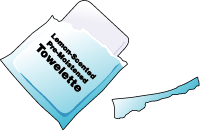Wetwipes
Created | Updated Nov 13, 2006

Wetwipes (also known as babywipes) have become an everyday item in today's society, but, hard though it may be to credit, there was a time when they did not exist.
What Are They?
Wetwipes are remoistened little towels, usually about 20cm square. They are sold in packs designed to keep this moisture in, by the use of a resealable patch, or in closable box. After use they are thrown away, as the moistening agent quickly evaporates on contact with air.
History: Start at the Bottom
First sightings were in eating establishments, where individually wrapped towelettes would be provided to diners of sticky finger foods, such as spare ribs or southern fried chicken1. But their rise in popularity is thanks to babies' bottoms. Prior to the invention of babywipes sometime around the 1980s, pooh-y bums had to be cleaned with swabs of cotton wool, which were far too small and fiddly to do the job properly. During the decade of big shoulderpads and women wanting to have it all, labour-saving devices became very marketable. This was rather surprising given the opposing anti-disposable, environmentally-friendly philosophy that was also prevalent at that time.
Size and Shape, Packaging
Early versions came in a cylindrical tub with a snap-close lid. As the user removed one wipe, the next would be cleverly pulled to the top of the tub, by means of the way in which the wipes were wound inside. However, if the user was unfortunate enough to lose the leading corner of the next wipe, it was a supremely difficult task to re-install, entailing opening up the tub, locating the free end, and re-threading it through the hole. In addition, the teeth of the opening could deliver a nasty scratch to the user's fingers. These wipes were quite fine and thin, a necessity derived from the intricate intertwining involved inside the tub2.
The next generation of wipes were much thicker and sturdier, and came in a rectangular box with a hinged lid that could be opened and closed with one hand. As these wipes were still primarily aimed at baby-bottom-cleaning operations, the ability to be used one-handed was a huge selling point. A later refinement was the refills, whereby the sturdy plastic box could be refilled with a pack of wipes. This cut down a little on the wasteful packaging, making them more appealing to those greenies who were still using cotton wool balls. The association with nappies and babycare continued, and it was major nappy manufacturers who marketed these new wipes eg, Pampers, Huggies.
Different Varieties
It soon became obvious to manufacturers that people were using their babywipes for more than just cleaning babybums. Packs of wipes were being carried around in cars to clean sticky fingers, or in the kitchen to give surfaces a quick lick-and-a-promise. The manufacturers quickly spotted the potential for specific use 'tailored' wipes, which would increase their profits significantly.
In the 1990s, 'antibacterial' was the flavour of the month3 and antibacterial kitchen and bathroom cleaning wipes were soon to be found beside the antibacterial washing up liquid and soaps.
These were followed by facial wipes, as the cosmetic industry caught the whiff of success. Facial wipes appeal to most women who find the chore of taking their make-up off before going to bed so off-putting that they ignore it4. With facial wipes there is no excuse! Cosmetic wipes constitute a whole range on their own, with specialised wipes containing eye-make-up remover, mattifying ingredients, deodourisers, toners and moisturisers. Nail varnish removing pads had been in existence prior to this, but these contain a highly toxic substance that should not be brought anywhere near the face. Some products have the outward appearance of being wipe-like (eg, Oil of Olay facials), but require to be moistened before use, which disqualifies them from further discussion here, and frankly, why bother buying them at all?
The little individual packs of wipes are still around, both in restaurants and on some airlines, who dish them out at take-off, or with the on board meal5. These are ideal for carrying around in the back pocket of ones jeans.
The newest wipes are the large floor cleaning wipes (eg, 'Swiffer' floor wipes, 'Vileda' products). These have been developed in conjunction with 'new improved'6 floor-cleaning techniques, and require a special sort of handle and base unit to attach the wipe onto.
The association with bums is still around, and brand spanking new7 moist toilet tissue has started to appear on the shelves alongside the normal dry toilet tissue.
Uses
Babycare, dining, personal hygiene, housework... the list is long. They are a boon to travellers, not only in the car or train, but also to campers who may be many miles from showering facilities, and who can use them for an instant freshen-up.
Availability
Wipes of all descriptions are available from most supermarkets. Large chemists8 stock a wider range from the plethora of cosmetic wipes. They are a relatively cheap item, costing less than 5€ per pack on average.

